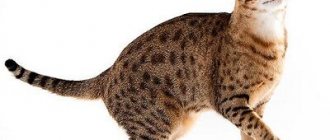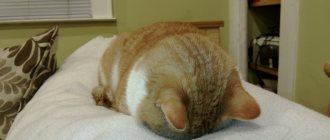When you need help
A first-time cat requires extra attention.
Pedigree representatives of the cat family, dwarf breeds, “problem” females who have congenital or acquired pathologies, and primiparas need help.
Is it possible to induce labor in a cat on your own? In some cases, it is not only possible, but also necessary. As a rule, pregnancy in cats lasts 55-60 days. A slight delay in the birth of kittens is normal, but if the animal does not give birth 68-70 days after mating, measures must be taken. The babies grow in the mother's womb, becoming larger and larger, and the larger the kittens, the more complications the birth will be.
There are cases when a cat, having just given birth to her cubs, does nothing towards them. Then the owner of the new mother must get down to business.
The kitten needs to be helped to free itself from the amniotic sac and gently blow into its nose. Then squeeze the umbilical cord at a distance of a couple of centimeters from the baby, tie it with surgical thread and trim it with sterile scissors. The wound should be smeared with green paint, and the baby should be pushed towards the mother’s nipples.
To prepare for the birth of your mustachioed pet, you can read a lot of information, watch videos on the Internet and follow all kinds of advice. And if everything goes smoothly, the cat can easily give birth. But, no matter what knowledge and skills the owner of a pregnant cat has, if during childbirth there are doubts about the correctness of what is happening, it is imperative to take action and call a veterinary obstetrician. It’s better to play it safe so that everything goes well for the new mother and her cubs.
Whether you're a purebred breeder or the owner of a pregnant cat, it's important to know what to do when your cat goes into labor and starts having kittens. As a rule, pregnancy in cats lasts 65-67 days, so when you know for sure that your cat is pregnant, start preparing for the birth. In this article we will tell you how to do this.
What to prepare for childbirth
The closer the kittens are born, the more attention the cat owner should pay to preparing for this event. First of all, you need to prepare a bed for the expectant mother; it is advisable to place it in a warm place. It’s better to lay down old things that you won’t mind throwing away, as they will definitely get dirty. It should be noted that synthetics can have a bad effect on the condition of newborns, so it is better to use natural fabrics.
In addition to the fact that the owner must know what to do when a cat gives birth, he must know what may be needed during childbirth.
A powdered cat's milk replacer may be needed if the birth is difficult.
You should prepare a set of necessary things. This includes:
- surgical gloves;
- scissors;
- clean cloth or towel;
- petrolatum;
- warm heating pad;
- dry cat milk replacer;
- antiseptic, for example alcohol.
Milk will be needed in case the cat has a very difficult and protracted labor, that is, she may not feed the babies at first. In this case, a person will have to take on the role of the cat's mother.
We suggest you read: How long does it take for a cat to give birth?
It is very important that the place where the cat will give birth is quiet and not too bright. You don't need to gather a whole crowd to deliver an animal. In most cases, cats cope well with the task on their own, and those present will only irritate her.
Before giving birth, the cat begins to meow loudly
What to do if a cat cannot give birth?
The physiological norm for domestic cats is the birth of kittens at 64-70 days. Childbirth, from the passage of the plug to the appearance of the placenta of the last kitten, should be completed within a day, although in fact the process goes faster.
Any deviation is considered a pathology.
The cause of pathological childbirth can be:
- low-fertility litter of large kittens;
- incorrect presentation of the fetus;
- stillbirth;
- weak labor activity;
- inflammatory process;
- consequences of injury;
- anatomical features of the structure of the birth canal;
- dry birth canal;
- weakening of the uterine tone and weak abdominal muscles of an older cat;
- characteristics of some breeds;
- overfed cat;
To be prepared for various surprises, before giving birth it is necessary to study all the literature on the topic that is in the public domain; at 7-8 weeks of pregnancy it is advisable to do an ultrasound - an experienced veterinarian will determine the expected number of kittens in the litter and warn about possible pathology, if any.
For your own peace of mind, it is advisable to agree with the veterinarian about the possibility of calling at night and coming for an urgent call.
If the kitten emerges from the birth canal, but gets stuck with a shoulder or limb, and when the pushing ends, it is pulled back, you can do two things:
- During the next contraction, you need to use a gauze napkin to take it by the skin along the spine and hold it, not allowing it to hide. At the next contraction, he will stick out a little more, then, accordingly, intercept him a little further, and so in 3-4-5 contractions you will help him be born.
- Take the cat by the scruff of the neck and shake it, at the same time placing your palm under the loop so that the kitten falls onto your palm. When cats are picked up by the scruff of the neck, an instinctive relaxation of the muscles occurs - this is how mothers carry kittens.
ATTENTION! You can’t hold a kitten by the limbs, much less pull; very weak joints can easily be damaged or even tear off a paw!
You can determine the presence of unborn kittens in the uterus as follows: you put the cat on its hind legs, holding it under its front legs with one hand, and carefully feel its stomach with the other hand.
If you feel one lump, it means the birth is over; this lump is a swollen uterus. If there are several seals, it means that labor is not over yet.
If there are several kittens in the litter, not all of them were born, and you know for sure that there should be another kitten, but the cat is tired and labor has weakened, you can inject her with oxytocin.
Pharmacy oxytocin ampoule 1 ml is taken in equal parts into 3 insulin syringes and injected subcutaneously along the spine with an interval of 20 minutes: injection, 20 minutes - second injection, 20 minutes - 3rd injection.
ATTENTION! Oxytocin can only be injected if the birth canal is open, otherwise stimulation of pushing can lead to uterine rupture.
In case of a long labor, an injection of the drug Tramatin will help the cat survive stress and pain. The dosage is calculated according to the weight of the animal according to the instructions for the vaccine.
During prolonged labor and a large time interval between the birth of kittens, the natural lubrication of the vagina with amniotic fluid dries out.
To help the cat give birth and make it easier for the kitten to pass through the birth canal, 1 ml of sterile oil is injected into the vagina with a syringe without a needle.
During a long labor, a cat loses a lot of fluid. To restore strength, you can inject her with a glucose solution, but in order not to injure her with unnecessary injections, it is better to draw honey water into a syringe without a needle and give her 5-10 ml of this composition.
The syringe is inserted from the side, into the gap between the fangs and molars.
If the unsuccessful birth continues for more than a day, the help of a veterinarian is needed; most likely, your cat will need a cesarean section. On the second day, unborn kittens can die in the womb and cause intoxication in her body.
A newborn kitten is always a joy for all inhabitants of an apartment or house. You need to prepare for it in advance. Despite the fact that a cat knows at the genetic level how to survive in nature, it is not always able to survive this process on its own. Therefore, every cat owner should know what to do if the cat cannot give birth.
There are cases when, if help was not provided, a pet began to die from various complications. This usually affects artificially bred breeds that have undergone changes at the genetic level and cannot reproduce normally. Therefore, they are not able to cope with what ordinary yard animals can easily cope with.
The minimum pregnancy period for a cat is two months, and the maximum is almost 11 weeks. It all depends on the breed of the pet. So, a cat with short hair or no hair at all bears kittens for up to 2 months, and with long hair it bears kittens to the maximum.
The number of kittens also influences the gestation period. The more there are, the less time the cat bears them and the more difficult it will be for her to give birth. And if there are no more than two of them, then they may be late with childbirth. The pregnancy count begins from the moment of conception, which occurs 25-50 hours after the end of mating.
- For 8 hours, the cervix is dilated;
- Smooth muscles begin to contract;
- The abdominal muscles contract;
- Contractions alternate with pushing;
- The birth of kittens ends with the release of the placenta.
- Large fruit size;
- His position is wrong;
- Fetal death;
- Weak contractions;
- Weakened abdominal muscles;
- Injury received;
- Inflammatory processes;
- Narrow pelvis shape;
- Insufficient dilatation of the cervix;
- Features of the anatomical structure of the vagina and its vault;
- Lack of lubrication in the birth canal;
- Significant age of the cat;
- Presence of obesity;
- Features of a specific breed, Persian and Himalayan cats especially suffer from this.
- The cat gave birth to one and does not give birth again;
- The fruit has entered the canal, but there is no further progress;
- The cat gave birth to a kitten and does not give birth again for more than two hours;
- The cat's temperature rose sharply, apathy and weakness appeared;
- Bleeding occurred, with a volume of more than two teaspoons for more than 10 minutes;
- The cat does not give birth to the next kitten for a long time, more than 2 hours (in this case, urgent medical attention is required).
- When the cat is nervous. It is necessary to calm her down by stroking her and talking to her gently. You can even very gently massage the belly, stroking it from the throat to the hind legs.
- If attempts begin, you can place your palm under the hind legs to make it easier for the cat to lean on;
- Sometimes you have to help when the kitten begins to emerge from the birth canal;
- Help the kitten to get out if he does it backwards so that he does not suffocate.
- Short-haired and hairless breeds carry their offspring for approximately 55–65 days.
- Long-haired females - up to 75 days.
For some time after childbirth, uterine contractions may continue and bloody mucous discharge may occur. But this does not prevent the cat from giving birth and is a common occurrence.
Pathological birth
To avoid many problems, it is best if your pet is monitored by a veterinarian throughout the entire pregnancy. He must know all the characteristics of his patient if he suddenly has to help the cat give birth. Sometimes a woman in labor may need to be hospitalized.
It is also worth considering that cats sometimes delay the birth process on their own. This usually happens if something makes them uncomfortable. In this case, there is no point in helping, but you just need to try to understand what is preventing them from giving birth. Such factors may include sharp and loud sounds, drafts, or the lack of a suitable place for childbirth. Also, a cat can be irritated by strangers, strong odors, and the presence of other animals.
In a word, all the owner’s help consists of monitoring to ensure that there are no complications and that the cat can give birth as calmly as possible. If they occur, you should contact your veterinarian.
In addition, in cases where the cat has not given birth to all the kittens or she may give birth to a dead kitten, it is necessary to urgently call a doctor to save the life of her and those kittens that are still alive.
The duration of pregnancy in cats varies from sixty to seventy-five days.
Pregnancy in cats lasts from 60 to 75 days.
The duration of pregnancy depends on the number of kittens. The more babies a mother has inside, the faster labor can occur. Conversely, one or two babies may be born late.
Conception usually occurs after 25–50 hours, from which point it is customary to begin the countdown.
Breeding of cultivated cat breeds and targeted selection aimed at fixing various mutations in breeds over the past 130-150 years have led to a weakening of natural instincts and their health in general, and now many purebred cats are not able to produce offspring without human help.
Moreover, there are a number of breeds whose representatives are at risk. This article is about problems with giving birth to cats, problem breeds and ways to overcome some problems at home - what to do if a cat cannot give birth on its own.
Normal labor in cats lasts no more than 18 hours. If within 24 hours your pet has not given birth to a single kitten, then this is a significant reason for concern. What can you do on your own if your cat cannot give birth and how to avoid harm?
How does a normal pregnancy and childbirth proceed?
The minimum pregnancy period for a cat is two months, and the maximum is almost 11 weeks. It all depends on the breed of the pet. So, a cat with short hair or no hair at all bears kittens for up to 2 months, and with long hair it bears kittens to the maximum.
The number of kittens also influences the gestation period. The more there are, the less time the cat bears them and the more difficult it will be for her to give birth. And if there are no more than two of them, then they may be late with childbirth. The pregnancy count begins from the moment of conception, which occurs 25-50 hours after the end of mating.
A normal pregnancy consists of the following stages:
- After a month, the nipples become larger. The cat begins to sleep more and move less. Appetite increases, and the stomach becomes 15 mm larger, becoming round and firm. At the same time, it becomes possible to feel the embryo.
- After 35 days, the belly begins to increase even more if there are more than two kittens there. Otherwise, its volume does not change. You cannot palpate the abdomen at this time.
- After 40 days, the fruits begin to develop rapidly. Fur begins to grow on them. During this period, the cat begins to eat less.
- After 50 days, the kittens inside the mother begin to behave more and more actively. The first sign of impending labor is relaxation of the pelvis. This is followed by the release of colostrum, mucus, etc. At the same time, the cat is actively searching for a safe place.
Childbirth consists of the following periods:
- For 8 hours, the cervix is dilated;
- Smooth muscles begin to contract;
- The abdominal muscles contract;
- Contractions alternate with pushing;
- The birth of kittens ends with the release of the placenta.
For some time after childbirth, uterine contractions may continue and bloody mucous discharge may occur. But this does not prevent the cat from giving birth and is a common occurrence.
How to tell if your cat is going into labor
There are some visible signs that help the hostess guess that the climax is approaching:
Among other things, the pet looks for a secluded corner and hides, or, on the contrary, tries to climb in and hide under the owner’s blanket.
In the later stages, you need to be prepared for childbirth.
For such an important event, of course, you need to prepare in advance.
The female domestic cat reaches sexual maturity by 6–8 months of age. After this, if the owner is not going to sterilize his pet, he should be ready to give birth. But sometimes the animal’s labor is delayed, and it is necessary to stimulate it.
Correct care for a woman in labor
In the wild, cats give birth on their own, but in domestic cats, their natural instincts are muted. For this reason, it is desirable that the owner be nearby during childbirth and can provide the necessary assistance in a timely manner. It is especially needed for a cat giving birth for the first time. The pet can only guess what will be required of her. The owner’s task is to act competently and, if necessary, call a veterinarian.
Correct actions with the amniotic sac
If the bubble with the kitten inside is not damaged, if the fetus lies correctly head first, then your help will not be required. You need to intervene in the following cases: - if the bubble is torn, prepare a clean cloth, wrap it around the kitten and gently pull at the next contraction; - if the bladder is torn and the kitten is walking butt, pull without waiting for a contraction, speed is more important so that the baby does not suffocate.
If the cat does not chew the amniotic sac, this must be done for her. You will need sterile scissors. Act quickly - if you wait more than half a minute, the kitten may suffocate.
If the kittens are too big
It is difficult for a cat to give birth to large babies. It will also be difficult for you to remove the kitten; it will slip back into the vagina. If your cat's vulva is dry, lubricate it with Vaseline or lubricant. Proceed as follows: - wait for the next contraction when the baby approaches the vulva; - insert the index finger of a sterile-gloved hand into the vulva a few centimeters and move the skin towards the anus; - as soon as the kitten appears, grab it and move it slightly to help it come out. Determine the intensity of the impact yourself individually.
What to do if a kitten gets stuck
A few hours before birth, kittens take a forward-facing position. But sometimes babies change position or their head is turned to the side, making it difficult to exit the vulva. To help a stuck kitten be born, lubricate the vulva with lubricant or Vaseline and with a sterile gloved hand perform the following manipulations: - carefully insert your finger into the baby’s mouth, if the amniotic sac allows it; — turn the kitten’s head in the right direction so that the cat’s contractions push it further; - press on the cat's perineum at the bottom of the anus - this will cause a contraction, and the baby will not be able to return back.
We do the same if the kitten moves forward with its sacrum - grab it by the paws and guide it along the birth canal.
It happens that for some reason kittens die in the womb. In this case, they will still be born naturally. The cat will go into labor, and if your help is needed, you can act less carefully. It is important that everything is in order with the cat, so if the fetus is stuck, feel free to pull on any part of the body.
Problem breeds
Some cat breeds are more likely than others to experience problems during childbirth:
- Breeds with large heads - British, Persians, exotics.
- Breeds with possible natural deformation of the bones are bobtails, Cymric and Manx cats, Scottish and Highland folds and straights.
- Breeds with shortened limbs - munchkins, bambinos, dwelfs.
It is especially difficult for Persian and exotic mothers to give birth, since they often have small litters of large kittens, which also have very large heads. Therefore, it is imperative to monitor your cat’s weight during pregnancy without overfeeding her.
Duration and phases of pregnancy
The phases of pregnancy in cats can be divided into 3 main phases.
Week 1-3
There are practically no changes in the cat’s behavior in the first 3 weeks. You may notice less appetite, drowsiness and decreased activity. You can't tell if a cat is pregnant by looking at its nipples. You can notice a change in their color and size only after 3-4 weeks.
At 3 weeks, cats may begin to vomit. It usually lasts 3-4 days or can be one-time. The symptom is associated with stretching of the uterus and hormonal changes in the animal’s body.
Week 4-6
At 5-6 weeks, small embryos can already be felt in the cat’s abdomen. This must be done very gently and carefully. Starting from the 5th week, cats' bellies begin to round. However, sometimes this is not noticeable at all until 7-8 weeks. This is especially true for cats pregnant with only 1 kitten.
Week 7-9
After the 7th week of pregnancy, you can even feel the number of kittens in the cat’s stomach by gently feeling their heads. The movement of the fruit becomes distinct and very noticeable.
The cat's behavior begins to change at 8 weeks. Before giving birth, she becomes restless and follows the owner's heels. At week 9, the cat may become apathetic and very detached from the family and other pets. This reaction is completely normal.
Our pets can only rely on us. Only the owner can help an animal if it is scared, in pain, or if something threatens its life. In the same way, a cat needs human help during childbirth. A responsible and caring owner who is ready for the birth of his pet is the first assistant. Proper preparation for the birth of kittens can save the lives of babies and their mothers.
How long does it take for a cat to give birth?
Moreover, the first and second phases are periodically repeated with each born kitten, and the third, the final, passes very quickly and almost imperceptibly.
First phase
The first phase is the weakening of the cervix, vagina and the beginning of uterine contractions. Contractions “change places” with relaxations. The pelvic muscles are relaxed, the perineum becomes more elastic and increases in diameter.
The process itself has not yet begun, but you can already feel, if you put your hand on the stomach, the movement of the kittens inside. Heavy breathing, change in behavior - the pet often runs to the box, rummages through it, indicating the completion of the first phase.
In primiparous females, this phase can last about 36 hours.
Second phase
The second phase is characterized by more frequent and painful contractions, which is provoked by the movement of the first kitten towards the exit. At the very edge of the perineum, the amniotic sac is visible, which bursts and some fluid flows out. At the same time, the cat pushes, helping the baby to be born.
This blood sac is the first kitten.
The process lasts from five minutes to half an hour.
Third phase
All kittens were born. The cat will lick the last one and will be ready to get rid of the placenta.
The third phase occurs after the birth of all kittens and consists of the release of the placenta. In the normal course, the amniotic sac comes out with each kitten, but it happens that it is delayed and two come out together, after the birth of the next baby.
Third phase
Critical course of labor
We must call the veterinarian if:
- Childbirth is delayed by more than 10 days.
- The kitten remains in the birth canal for more than 30 minutes.
- More than 5 strong attempts without the kitten exiting the birth canal.
- 10 minutes of strong contractions with squeezing the amniotic sac into the birth canal.
- Increased temperature or fever.
- Copious discharge of scarlet or dark brown color, “putrid” smell of discharge.
Important! A pregnant cat chooses where to build her nest. If the animal does not treat the box well and stubbornly settles down in the closet on your favorite shirts - give in, free up the place you like and arrange it comfortably, the cat will still do it in its own way. Some cats, especially first-time cats, give birth “wherever necessary” - be prepared.
When should you sound the alarm?
Of course, the easiest way is to say: if something is wrong, you need to see a veterinarian, but this is not always and everywhere possible, so we will look at some aspects of labor in more detail.
A condition in which a cat is unable to push the fetus out of the uterus is called dystocia. Let's consider what to do if the cat cannot give birth on its own.
Signs of an abnormal birth process may include:
- Long (more than 12 hours) and intense inconclusive labor pains.
- Bleeding that lasts more than 10 minutes and is more than 2 teaspoons in volume.
- Sudden cessation of labor and cat apathy with unborn kittens.
- a gap of more than 2 hours between the birth of kittens.
- Heat.
It is important to remember that cats can delay childbirth for a day if they are not sure of safety, or something is bothering them, and this is considered the norm.
Pathological birth
However, not everything always goes as it should, especially if childbirth is the first time. Cases when a cat cannot give birth for any reason are called pathological births. There can be a lot of reasons for this. The most common are :
- Large fruit size;
- His position is wrong;
- Fetal death;
- Weak contractions;
- Weakened abdominal muscles;
- Injury received;
- Inflammatory processes;
- Narrow pelvis shape;
- Insufficient dilatation of the cervix;
- Features of the anatomical structure of the vagina and its vault;
- Lack of lubrication in the birth canal;
- Significant age of the cat;
- Presence of obesity;
- Features of a specific breed, Persian and Himalayan cats especially suffer from this.
To avoid many problems, it is best if your pet is monitored by a veterinarian throughout the entire pregnancy. He must know all the characteristics of his patient if he suddenly has to help the cat give birth. Sometimes a woman in labor may need to be hospitalized.
A cat cannot give birth at home
It happens that all the due dates have passed, but the cat does not even think about giving birth. In such cases, you should definitely contact your veterinarian.
Oxytocin and its derivatives can provoke cervical rupture in a mother who is not ready for the process. Traditional methods will complicate and prolong childbirth and provoke weak attempts.
Primiparous females are often better than their “experienced” friends. This behavior is determined solely by the first experience. All that is required from the owner is to reduce the pet’s stress as much as possible by calming, stroking, and speaking kind words. Sometimes it is necessary to resort to medicinal sedation, giving sedatives to relieve tension.
If your cat needs help during the birthing process, she will let you know.
Most often, mothers themselves know what needs to be done, but sometimes a little assistance is needed. When the pushing begins, you can place your palm under the hind legs so that mommy can rest. During pushing, spontaneous bowel movements may occur - you should keep cleaning supplies nearby.
An attempt to turn the kitten face forward during birth.
The appearance of the amniotic sac requires special attention. If the baby walks butt forward, you can try to turn him around. Lubricate your little finger with Vaseline and carefully insert the shell back. Place the woman in labor on her hind legs, while supporting her front legs, and gently shake off her body. The kitten should turn around on its own in this way.
It is permissible to stroke all the time, lightly resting on the chest area. This will help with pushing. In the case when the water has already broken, the fetus is within visible limits, and the contractions have suddenly stopped, oxytocin can be used to stimulate contractions. For this, a tenth of an ampoule. The needle, after treatment, must dry out due to the destruction of oxytocin when interacting with alcohol.
You cannot pull the kitten out of the crotch. You can help widen the passage with a Vaseline-lubricated finger, carefully and very slowly pushing the boundaries. If the measures taken do not produce results, call a veterinarian immediately.
During the normal course of labor, you can help by pulling the afterbirth a little towards you and letting the woman in labor eat it. If the mother does not lick the baby, free him from the film, wipe him with a dry cloth, and give him to the mother.
In between contractions, the mother can feed the kittens, you can give her some water, but under no circumstances feed her. When the next contractions and attempts begin, the babies should be removed from her.
It is necessary to compare the number of kittens and placentas. In nature, a cat eats the placenta, which contains nutrients.
The afterbirth remaining inside will create a pathogenic environment, which will lead to serious inflammation and subsequent bad consequences. The appearance of the fetus with its paws forward is also a pathology. You need to carefully push it back in. With repeated contractions, the fetus may be delivered correctly.
The cat ruptures the amniotic sac during childbirth on its own.
The cat itself must rupture the amniotic sac, otherwise you need to tear the film yourself from the side of the baby’s face. The newborn should squeak. If this does not happen, you can try to revive him. To do this, turn it over with its paws down, holding its head, shake it a little, pressing on the chest to allow fluid to drain out of the lungs. You need to act carefully so as not to damage the fragile cartilage.
If the cat no longer has babies, its belly becomes soft and elastic within half an hour. This can be determined by palpating the abdomen. However, this data does not apply to the case if oxytocin was used for stimulation. The abdomen may be tense for a longer period.
If you notice that the cat is already tired, her contractions have weakened, then try putting her on the bed or sofa, stroking her back (from the neck to the very tail). This will calm the animal, relax the muscles, and provide a kind of massage. The expectant mother will rest a little, recover and continue giving birth with renewed vigor. But if the pet is worried and tries to escape, it won’t let you handle it, don’t touch it. Excessive stress will only slow down labor.
Do not try to put pressure on the belly when squeezing out the kittens. Do not drag the emerging kitten (you can only be extremely careful and carefully support it), otherwise you will break the baby’s neck.
If your pet has not eaten for a long time, then offer her light food and water so that the cat can refresh herself. But do not try to force feed or water the animal. For those with a sweet tooth, you can offer some kind of sweetness so that glucose enters the body.
If you see that your pet is weakened, her health has deteriorated, the kittens were stillborn or do not appear for a long time, but the cat continues to push, immediately call a veterinarian at home or take the giving birth to the veterinary clinic yourself as soon as possible.
It is best to prepare in advance, find and negotiate with a veterinary clinic that has an ultrasound machine and an x-ray room. Using an ultrasound examination, you can find out whether the kittens are alive (the heartbeat will be heard). An X-ray examination will help the veterinarian see how the crumbs are located in the birth canal.
You can’t look at it in such detail on an ultrasound, because the kittens (if they are alive) will move and the muscles will contract. The veterinarian makes a decision based on the research data obtained: to perform an operation (caesarean section) or to get by with administering drugs to stimulate labor and maintain the animal.
Pregnancy in a domestic cat is relatively quick, lasting 55 to 60 days. Some individuals give birth completely independently and human participation in this process is not important to them. British cats, Sphynxes, Maine Coons or Persians require the obligatory assistance of the owner during childbirth or even the presence of a veterinary obstetrician.
It is advisable to know exactly how much time has passed since the moment the animal was mated, in order to be prepared for the required time.
The approach of “day x” will be indicated by the so-called harbingers of childbirth, during which the expectant mother is a cat:
- begins to look for a secluded place to build a nest;
- becomes very affectionate with a person, requires special attention to himself;
- may refuse to eat;
- begins to lick the swollen mammary glands.
A few days before the expected birth, you need to prepare the necessary list of things that may be needed to help the cat and her cubs:
- Childbirth box. Place in a secluded, warm place;
- Disposable diapers and sterile wipes;
- Disposable syringes and medications if there is a possibility of complications;
- Vaseline oil;
- Sharp scissors;
- Disinfectant solution;
- Surgical or silk thread to tie the umbilical cord;
- Iodine or brilliant green.
What to do: first aid
If you notice that the animal has apathy or other pathological symptoms, you can call a veterinarian at home to be safe from possible complications. With more frightening symptoms, such as the baby moving forward with his foot or when the cat cannot give birth for unknown reasons, you should immediately take your pet to a veterinary clinic. Before the doctor arrives, try to relieve the mother’s pain symptoms:
- Place the cat on a hard surface and massage, lightly stroke from neck to tail.
- Invite your pet to eat her favorite treat; under no circumstances force-feed her.
- Soak your cat with cool water.
Strictly prohibited manipulations:
- Prohibit the woman in labor from moving freely.
- Treat symptoms with medications and inject oxytocin yourself to activate labor.
- Squeezing out kittens by pressing on the mother's stomach can lead to uterine rupture or the death of the babies, especially if the fetus is born paws first.
- Forcing a cat to do something it doesn't want to do.
- Touch the baby that was just born. Resuscitation of a newborn kitten should only be carried out by a specialist.
The best option for the owner and the furry mother in labor would be inpatient hospitalization after the first signs of labor. In a veterinary clinic, the leading veterinarian, if there is the slightest threat, will always be able to perform a caesarean section on the cat or administer a drug to induce labor. If it is decided that the cat will give birth at home, at the end of the term, take it to a specialist for an examination, which will determine the possibility of giving birth to babies at home.
Any deviation from the natural course of the birth process indicates the presence of pathology, which may arise due to the following factors:
Aibolit set
To assist a cat that cannot give birth on its own at home, the first aid kit prepared for childbirth should contain:
- Oxytocin is an analogue of a natural hormone that causes increased contraction of the uterus and the arrival of mother's milk, increasing lactation.
- 10% glucose solution or honey water - a solution of 0.3 teaspoon of honey in 0.5 glass of water.
- Traumatin or human Traumgel.
- A pharmaceutical bottle of sea buckthorn or cedar oil, or a small amount of refined deodorized sunflower oil calcined over a fire.
- Syringes without needles for 5 and 2 ml, insulin syringe with a short needle - 3 pcs.
- Sterile gauze wipes or bandage.
Near the cat's maternity hospital there should be a disinfectant solution - chlorhexidine digluconate or any other pharmaceutical preparation for hand treatment.
Causes
Pathological childbirth can occur for a variety of reasons.
In most cases, they cannot be pre-controlled by the owner of the animal:
- large fruit size;
- incorrect location of the fetus in the birth canal;
- weak uterine contractions;
- infectious inflammation of the uterus;
- poor cervical dilatation;
- the presence of a secondary infection in the body;
- injuries;
- narrow pelvis;
- abnormalities in the structure of the vagina;
- uterine ruptures;
- insufficient abdominal strength;
- small amount of lubrication in the vagina;
- cancer, adhesions;
- torsion of the uterus;
- death of kittens in the womb.
The following factors may predispose you to a difficult birth:
- heavy weight;
- age;
- past difficult births;
- specific features of a particular breed (Himalayan, Persian);
- stress.
After childbirth
During the first 24 hours after birth, your cat will experience bleeding. A longer period of discharge is a reason to contact a veterinarian. After childbirth, a course of vitamins is recommended. It is advisable to introduce cottage cheese, sour cream, egg yolk, and milk into the diet.
When the cat’s stomach drops and the kittens inside are shaking, there is very little time left before giving birth. A cat's labor can be divided into three main stages.
This stage can last up to 24 hours. It all starts with a decrease in the cat’s body temperature by about two degrees. The animal begins to behave restlessly and often licks under its tail. Some individuals vomit.
It is necessary to move your pet to a “nest” specially prepared for childbirth and continue to be close to her. It is advisable for any cat to give birth at home, because a familiar environment is calming and helps to reduce anxiety at this most important moment.
During the first stage of labor, your cat's water breaks, then her breathing quickens, her heart rate increases, and contractions begin. The animal begins to purr loudly and even scream. At this moment, the owner’s support in the form of soft stroking on the tummy and a calm conversation will not hurt.
Babies begin to suck mother's milk immediately after birth. It is especially important that all newborns breastfeed immediately, since the first milk, called colostrum, is essential for the normal development of kittens. It contains special antibodies that are passed from mother to calf and support its immunity while it develops its own.
If the babies’ health worsens or the mother’s unwillingness to let them near the nipples, urgent help from a veterinarian is needed. A way out of this situation may be tube feeding.
In any case, the cat should be examined by a veterinarian the day after lambing to check its condition. In addition, the doctor will examine the kittens and determine whether they have enough mother's milk, both in quantity and quality.
If everything is going well for the cat and its offspring, you need to leave them alone for at least 1 month. The only exceptions should be cleaning the box, feeding and periodically checking the condition of the new family.
Harbingers of childbirth
Harbingers are considered to be changes in the animal’s vital activity within 24 hours before birth. The cat's uterus is arranged in the shape of the letter “Y” - the “horns” are the place of the kittens, the “tail” is the cervix. The main changes occur precisely in it, accompanied by discomfort or pain. Miscarriage and spontaneous childbirth are accompanied by the same symptoms, with one difference. Signs of premature birth in a cat most often occur 1-2 times faster.
We recommend reading: Paw Pad Disease in Cats Photos
As soon as you notice your cat's anxiety, pay attention to the following aspects:
- Most often, before the onset of contractions, a mucus plug comes out of the cervix - a small clot of a transparent, yellowish, greenish color, small brown inclusions are considered normal. You need to understand that the cork’s rejection may not be noticed. It can come out during urination or be torn off in parts - the cat licks itself, the discharge is unnoticeable.
- During pregnancy, kittens lie according to the “compact” principle, and for proper birth they need to turn around with their heads down. Large “babies” may not have time to do this, but during the process there is active movement of the fetuses - the kittens turn and push, causing a lot of inconvenience to the mother.
- The first contractions are barely noticeable, but can be felt if you put your palm on the cat’s stomach - the opening of the cervix begins, the process can take up to 8 hours.
Preparedness #1! Signs of an imminent birth in a cat are strong contractions, noticeable without palpation, the cat lies on its side or squats and arches its back - in the period from 5 to 60 minutes the first “baby” will appear.
What to do if the kitten is born too big
If you have a large fetus, it is recommended to choose one of the following methods for delivery;
- removing the kitten using forceps;
- C-section.
The first method can lead to unwanted complications for the kitten. For example, a leg may break because the muscle and bone tissue is not yet sufficiently developed. Therefore, doctors more often recommend surgery.
Cat with newborn kittens











